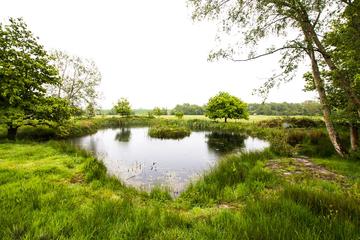Emily Seccombe, former MSc student at the School of Geography and the Environment, and Professor Rob Salguero-Gómez explain their recent research to improve habitat assessments for the protected great crested newt.
Amphibians are declining faster than any other vertebrate group worldwide, with climate change, disease, and habitat loss driving many species toward extinction. Among them, newts and salamanders are particularly threatened. Britain is a stronghold for the great crested newt (Triturus cristatus), supporting populations of international importance of this European Protected Species.

Potential great crested newt habitat.
Credit Emily Seccombe
Yet in Britain, the species is declining due to loss and degradation of their habitats through building development and agriculture. The great crested newt Habitat Suitability Index (HSI) is a critical tool used to assess their breeding habitat, used extensively by ecologists in conservation and development mitigation.
In our recent study, we critically examined the great crested newt Habitat Suitability Index, identifying key limitations and presenting an improved, user-friendly version designed to provide a more accurate reflection of a pond’s suitability. Our findings provide useful insight for ecologists conducting site assessments and monitoring habitats, and for conservation practitioners seeking effective tools to protect this declining amphibian.
Newts vs Development
In Britain, the great crested newt population is estimated to be declining by around 5% per year. The species is often portrayed in the media and political debate as a barrier to progress — blamed for holding up housing and infrastructure projects. Conservationists dispute this, highlighting other causes of development delays, emphasising the importance of healthy ecosystems for our economy and society, and disputing the “economy vs nature” rhetoric.
Key to this conflict is the species’ protected status, which requires developers to avoid damage to individuals and their habitat. This protection is vital for safeguarding a species in decline. Given the conservation status of great crested newts and the pressure to create more homes, it is essential that scientists, ecologists, and conservationists are able to provide accurate information about their habitat.
Limits to the current assessment approach
The current method for assessing a pond’s suitability for great crested newt breeding is the Habitat Suitability Index (HSI) developed by Oldham et al. (2000). This index is extensively used in a wide range of applications across Europe, including in development and conservation contexts and as an integral component of monitoring efforts.
Despite its management implications and widespread applications, there are significant concerns over the index’s accuracy and usage. The tool has now been used for over 2 decades and constantly increasing datasets provide an opportunity to revisit, test, and refine the index, an ambition set out in the original paper by Oldham et al. (2000).
An improved great crested newt Habitat Suitability Index
We used a multi-method approach including a literature review, a survey of Habitat Suitability Index users (mostly professional ecologists), and ecological data analysis of over 9,000 ponds and were able to gain greater insight into the current index’s limitations.
We used these findings to produce a modified index which better reflects great crested newt presence/absence in ponds in Britain. Improvements include removing the indices for water quality and waterfowl, combining the index values in a simpler way, and creating a new scoring scheme for pond area. We also presented a list of further potential modifications warranting additional research, including possible changes to the guidance that supports the index.
Field usage of this newly proposed Habitat Suitability Index is welcomed, as is sharing of findings (such as ease of use or comparison with existing datasets) with the researchers.
An improved great crested newt Habitat Suitability Index informed by our findings could significantly benefit the species' conservation management. Critically, it would enable improved assessment of habitat created to mitigate development-related losses. Furthermore, it would allow improved monitoring of habitat trends, leading to more accurate assessment of great crested newt conservation status.